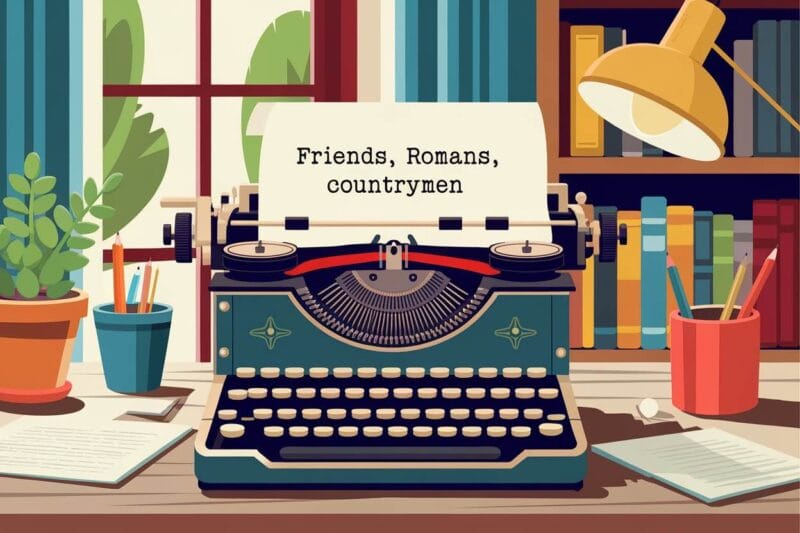Understatement operates by saying less than what is meant, often to ironic, humorous, or dramatic effect. Rather than expressing an idea in full intensity, the writer deliberately minimizes the force of what is being described. This reduction is a rhetorical strategy that is sometimes used to highlight the extremity of a situation, sometimes to inflect tone with subtlety, and often to resist exaggeration through refinement.
Writers employ understatement to shape voice, reframe the obvious, or keep emotion from overtaking the shape of the sentence. Whether used for irony or for restraint, understatement makes room for inference and tension. It reshapes intensity not by amplifying it but by constraining it.
Understatement as Controlled Displacement
Understatement does not simply reduce expression but shifts the center of gravity away from what is spoken and toward what remains unspoken. Its effect depends on the tension between the language used and the situation being described. When the phrasing seems too mild for the occasion, the surrounding context sharpens its impact. The result is not a diluted message but a carefully measured restraint. The speaker withholds, not to avoid clarity but to heighten the charge beneath the words.
Understatement works by tightening the scope of language until the context begins to bear the pressure directly. The speaker’s minimal phrasing presses against the scene’s intensity, setting up a quiet friction between word and event. A line such as “We had a bit of a situation” during a crisis shifts attention away from the drama and places it on the speaker’s composure. The mismatch carries its own charge, one sharpened by control rather than force.
Strategic Uses of Understatement in Literature
Writers have long used understatement as a literary device to achieve effects that direct description cannot. It can create subtle irony, control pacing, or sharpen contrast without drawing overt attention to itself.
Understatement as Irony
Understatement often serves as a kind of reverse hyperbole where the expected intensity is withheld rather than exaggerated. The gap between what is said and what is meant becomes a source of irony.
In The Sun Also Rises (1926), Ernest Hemingway writes, “I was a little drunk. Not drunk in any positive sense but just enough to be careless.” The line downplays the character’s condition in a way that carries more than it concedes. By avoiding sensationalism, Hemingway heightens the stakes through understatement, letting the damage surface through the speaker’s refusal to fully acknowledge it.
Understatement as Emotional Compression
Understatement compresses emotional force rather than suppressing it. This technique becomes especially effective in writing that confronts devastation without embellishment. The language recedes, and what remains is shaped by omission rather than excess.
In Cormac McCarthy’s The Road (2006), a father and son travel through a ruined world, and moments of despair are often described without sentiment. One passage reads: “He walked out in the gray light and stood and he saw for a brief moment the absolute truth of the world. The cold relentless circling of the intestate earth. Darkness implacable.” There are no cries of anguish or elaborations on loss. The scene is stripped of response, and what remains is a starkness that intensifies the gravity of what has occurred.
Humor Through Deflation
Comic understatement hinges on the absurdity of soft language used in absurdly inappropriate situations. In Oscar Wilde’s The Importance of Being Earnest (1895), characters often reduce scandalous events to trivial concerns, such as “To lose one parent may be regarded as a misfortune; to lose both looks like carelessness.”
The comedy arises from the mismatch between tone and circumstance, making the understatement the mechanism of wit.
Other Famous Examples of Understatement
Some of literature’s most memorable lines draw their strength from understatement. Its ability to imply rather than declare makes it an enduring technique across genres.
- In Jane Austen’s Pride and Prejudice (1813), Mr. Bennet says to Elizabeth, “Your mother will never see you again if you do not marry Mr. Collins, and I will never see you again if you do.” The line reduces an emotionally charged dilemma into a deadpan ultimatum, turning familial pressure into sharp satire.
- In Joseph Conrad’s Heart of Darkness (1899), Marlow says, “The conquest of the earth… is not a pretty thing when you look into it too much.” The understatement here delivers a quietly scathing commentary on imperial violence.
- In poetry, understatement often pairs with lyric detachment. In Robert Frost’s Out, Out— (1916), after a boy’s fatal accident, the final line reads: “And they, since they / Were not the one dead, turned to their affairs.” The calmness strips the moment of sentimental framing, amplifying its bleakness.
Understatement vs. Related Concepts
To better understand how understatement works, it helps to examine its relationship to other rhetorical devices.
Litotes
Litotes is a form of understatement that works by negating the opposite of what is meant. For instance, “He’s not exactly a genius” implies someone is quite unintelligent. It’s a subtle form of criticism or praise, depending on the context.
While all litotes are understatements, not all understatements are litotes. Litotes carries a specifically ironic edge by using negative constructions.
Understatement vs. Hyperbole
Understatement and hyperbole move in opposite directions, each reshaping expression through contrast. Where understatement reduces emphasis by narrowing the language, hyperbole expands the sentence beyond proportion. One works through restraint, the other through escalation, but both rely on deliberate distortion to redirect focus.
Why Writers Use Understatement
Understatement offers precision where exaggeration might distort. It trusts that suggestion can carry more than declaration. Writers who use it are not avoiding strong material; they are recontextualizing it through tone, implication, and composure.
The effect often lies not in the words themselves but in the reader’s recognition of what has been withheld. The minimal phrasing holds firm against the urge to explain, choosing precision over display. By limiting expression, understatement draws the moment tighter. It avoids embellishment not out of caution, but to keep the line exact and controlled.
Further Reading
Is the British art of understatement ever so slightly dying out? by The Guardian
The Power of Understatement in Fiction Writing by Carmel Bird, janefriedman.com
What is Understatement? || Oregon State Guide to Literary Terms by Oregon State University
The Art of Understatement: How We Use Deception to Communicate Truth by Ellen Vrana, The Examined Life




